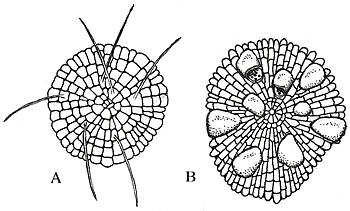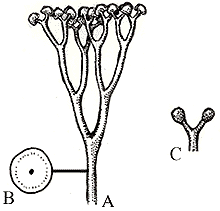![[Laboratory IV - Early Land Plants]](ElpD/ElpfontN.jpeg)
![[Laboratory IV - Early Land Plants]](ElpD/ElpfontN.jpeg)
Beginning with this lab, we have tried to organize our systematic study of ancients plants by evolutionary lineage wherever possible. You should refer to the Virtual Paleobotany Laboratory for a composite cladogram with the current best interpretation of evolutionary relationships between extinct and extant plants discussed in this course. As you will see from that presentation, the early land plants discussed in this lab are completely paraphyletic. Why, then, do we discuss them together in a single lab? From the point of view of a botanist visiting the Silurian or Early Devonian, when these plants lived, the plants grouped together in this lab would represent the monophyletic crown group of embryophytes. Therefore, from a truly (Earth) historical perspective, we should consider these early plants together.
Among the earliest evidence of land plants ( embryophytes ) are, as you might expect, fossils of reproductive bodies ( spores or cysts), because these are abundantly produced, highly transportable, and probably among the first plant structures to incorporate degradation-resistant chemical compounds (particularly sporopollenin ). Such remains are recovered from the uppermost Ordovician and Lower Silurian siltstones and shales worldwide. If you are sampling marine rocks, however, it is difficult to establish a terrestrial origin for these fossils. The least equivocal microfossil evidence of early land plants would be trilete spores (which are not produced by algae), tracheids, plant cuticle (with stomata to distinguish it from some arthropod cuticle, which may look quite similar), and tetrahedral tetrads of spores (VG 1:4). All of these structures are synapomorphic to the land plants (embryophytes ) and so provide good evidence of the existence of this clade. However, we have few clues as to what these plants might have looked like or where they lived.

|
Figure 4.1: Spore tetrad resulting from meiosis. |
Observe slides of macerated material from the Lower Silurian (Llandoverian) Tuscarora Formation of central Pennsylvania. These sediments were probably deposited in the estuarian wetlands behind coastal dunes.
One important hint to the parents of the early spore tetrads comes from the cladogram itself. The fresh-water green alga Coleochaete (Figure 4.2), which is sister to the land plants, covers its zygote in sporopollenin. However, covering meiotic products (spores) with sporopollenin is a derived trait of the embryophytes. Surveying the next-derived embryophyte clades, we learn that some basal liverworts disperse their spores in tetrads, similar to those found in the Late Ordovician and Silurian. Therefore, a reasonable working hypothesis is that the early tetrads are produced by early bryophytes similar to liverworts, with the single dispersed spores that occur later being produced by later-evolving lineages such as hornworts, mosses, and vascular plants (tracheophytes).
Modern embryophytesembryophytes attest to the evolutionary proliferation of a single lineage of green algae that established a megascopic terrestrial flora. However, it is likely that the invasion of land was attempted by several groups, most of which were ultimately unsuccessful. We leave our phylogenetic framework for a moment to look at some of the early land plants that have boggled attempts at evolutionary classification.
Examine specimens of Parka (Figure 4.2) (VG 1:6), Prototaxites (VG 1:7), and Protosalvinia (a.k.a. Foerstia)(VG 1:8)(VG 1:9). Some of these plants are thalloid much like early liverworts, hornworts and mosses might have been. Some have tubes, but their tubes are unlike those of any living organism. Reproductive structures are rare and confusing. However, it remains a paleontological truth that fossils belonging to entirely extinct lineages are the most difficult to understand.

|
| Figure 4.2: (A) Coleochaete (living), and (B) Parka (Upper Silurian - Lower Devonian), which some authors have suggested may be related to Coleochaete. What do you think? |
The oldest demonstrably vascular plant is the Late Silurian genus Cooksonia (Figure 4.3) (VG 1:10)(VG 1:11), originally described from Wales. Cooksonia is characterized by small, slender axes that branch dichotomously. In fertile specimens, sporangia terminate each branch tip. Rooting structures or rhizomes have never been found, probably because most Cooksonia specimens are allochthonous, having been broken off and transported before burial. Cooksonia is only known from compression/impression fossils, so determining that it is a vascular plant is difficult. A few lucky specimens contain a suspicious dark trace in the center of the axis from which a few poorly-preserved conducting tubes have been isolated. However, other specimens lack this dark strand and it remains unclear whether this is a taphonomic artifact or whether some Cooksonia lacked conducting tissue. Cooksonia has also been discovered in eastern Europe and New York.

|
| Figure 4.3: (A) Cooksonia caledonica reconstruction. Note that the below-ground portions are unknown. (B) Schematic protostele in transverse section. (C) Cooksonia hemisphaerica ultimate segments with sporangia. |
As the cladogram available in the Virtual Paleobotany Laboratory shows, when several Cooksonia species are analyzed phylogenetically, they emerge as a highly paraphyletic grade. A grade is a group of organisms that have similar general organization but may or may not be related to one another. On first glance, the overall features of size and branching place all Cooksonia in a single group, a grade. However, closer evaluation of sporangial shape (Figure 4.4) shows clearly that there is more variation within the genus than was previously suspected. Since reproductive structures like sporangia are generally better phylogenetic characters than are branching patterns, this variation gives us clues to the evolutionary relationships in the group. This analysis further suggests that the genus Cooksonia may include plants related to both the most primitive vascular land plants (Rhyniophytes) and to the lycopsids (Lab V). Consequently, the genus Cooksonia is not an evolutionary group (clade), but a mix of plants that bear some overall similarity (grade) and are near to the major branching in land plant evolution that sets the lycopsids off on their own evolutionary trajectory. More on that in Laboratory V.

|
Figure 4.4: Major sporangial shapes found in Cooksonia. (A) C. hemisphaerica has rounded sporangia that are little more than swollen axis tips. (B) C. cambrensis' sporangia are spherical with a clear differentiation between branch tip and sporangium. (C) C. pertonii has sporangia that are elongated. (D) C. caledonica has distinctly reniform (kidney-bean-shaped) sporangia. |
![[Title Page]](ElpD/Elpbutt.jpeg) |
![[Glossary]](../VPLimg/Glossbutt.jpeg) |
![[Range Chart]](../VPLimg/Rangebutt.jpeg) |
![[Geologic Time Scale]](../VPLimg/timesbutt.jpeg) |
![[Next Page]](../VPLimg/Forward.jpeg) |

